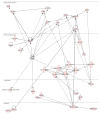Targeted tissue proteomic analysis of human astrocytomas
- PMID: 22794670
- PMCID: PMC3413268
- DOI: 10.1021/pr300303t
Targeted tissue proteomic analysis of human astrocytomas
Abstract
Complicating proteomic analysis of whole tissues is the obvious problem of cell heterogeneity in tissues, which often results in misleading or confusing molecular findings. Thus, the coupling of tissue microdissection for tumor cell enrichment with capillary isotachophoresis-based selective analyte concentration not only serves as a synergistic strategy to characterize low abundance proteins, but it can also be employed to conduct comparative proteomic studies of human astrocytomas. A set of fresh frozen brain biopsies were selectively microdissected to provide an enriched, high quality, and reproducible sample of tumor cells. Despite sharing many common proteins, there are significant differences in the protein expression level among different grades of astrocytomas. A large number of proteins, such as plasma membrane proteins EGFR and Erbb2, are up-regulated in glioblastoma. Besides facilitating the prioritization of follow-on biomarker selection and validation, comparative proteomics involving measurements in changes of pathways are expected to reveal the molecular relationships among different pathological grades of gliomas and potential molecular mechanisms that drive gliomagenesis.
Figures









References
-
- Lacroix M, Abi-Said D, Fourney DR, Gokaslan ZL, Shi W, DeMonte F, Lang FF, McCutcheon IE, Hassenbusch SJ, Holland E, Hess K, Michael C, Miller D, Sawaya R. J Neurosurg. 2001;95:190. - PubMed
-
- Ichimura K, Ohgaki H, Kleihues P, Collins VP. J Neurooncol. 2004;70:137. - PubMed
-
- Holland EC. Nat Rev Genet. 2001;2:120. - PubMed
-
- Maher EA, Furnari FB, Bachoo RM, Rowitch DH, Louis DN, Cavenee WK, DePinho RA. Genes Dev. 2001;15:1311. - PubMed
-
- Kitange GJ, Templeton KL, Jenkins RB. Curr Opin Oncol. 2003;15:197. - PubMed
Publication types
MeSH terms
Substances
Grants and funding
LinkOut - more resources
Full Text Sources
Medical
Research Materials
Miscellaneous

